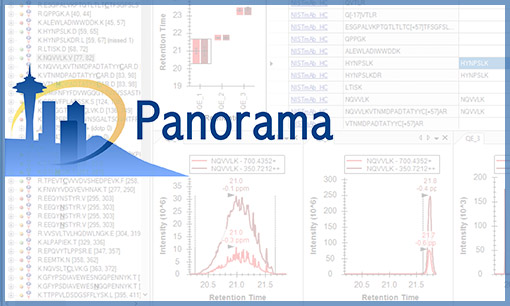Panorama is a web-based data management system for targeted mass spectrometry data that integrates closely with Skyline.
The Multi-Attribute Method (MAM) is designed for improved simultaneous detection, identification, quantitation, and quality control (monitoring) of molecular attributes. Our Panorama mass spectrometry software has recently added MAM-specific reporting to its existing set of analytics, offering immediate results and data sharing to any imported data. Additionally, Panorama and AutoQC’s automated workflow provide longitudinal tracking of MAM-related metrics for QC purposes.
Results: Skyline lets users easily set up the proteins and peptides to analyze, and pull in raw data from all of the major mass spec vendors without needing to do a separate conversion step. Panorama organizes data into folders, and offers different folder types that are optimized for different workflows and analyses. A new MAM folder type introduces predefined reports, including a Peptide map report and a Post-translational modification report which shows the proportion for each peptide variant’s peak area across samples. More MAM-focused reporting is being added, and at any time, data can be pulled into Spotfire, Tableau, or R for additional visualization.
Conclusions: Groups first started creating MAM-related reports in Panorama via custom SQL queries in 2015, but these were not built-in as standard reports or widely distributed. As interest in MAM has grown, the Panorama team saw the need to generalize them and make them broadly available. The initial set of reports include post-translational modification percent and peptide map reports. A collaboration between users and the Skyline and Panorama LC/MS development teams resulted in new capabilities to override how peptides and their variants are grouped when calculating the percentage that each variant represents of the whole. This flexible approach means that users can either use the default, which groups all PTM variants together, or group based on sequence variants or other factors. Supporting these reports directly also means that database schema changes and precalculation can speed up query times by 20x or more. Additionally, because Panorama can track a wide variety of data for automated longitudinal tracking, these MAM-related metrics can be easily incorporated into QC folders where they can be analyzed with statistical process control techniques like Levey-Jennings, CUSUM, and moving range plots. As of January 2020, more than 400 labs are using Panorama projects free of charge to manage targeted mass spectrometry assays on a server hosted by the MacCoss lab at the University of Washington. Additionally, major pharmaceutical companies and other organizations have deployed their own in-house installations of Panorama.
